CHEVROLET TRACKER 1996 Owner's Guide
Manufacturer: CHEVROLET, Model Year: 1996, Model line: TRACKER, Model: CHEVROLET TRACKER 1996Pages: 387, PDF Size: 18.54 MB
Page 31 of 387
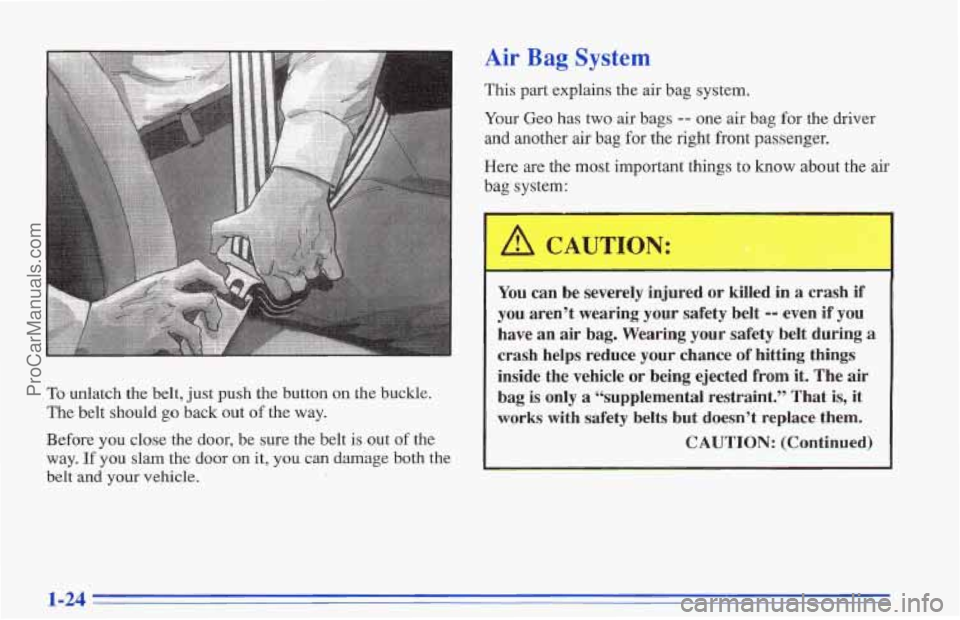
Air Bag System
To unlatch the belt, just push the button on the buckle.
The belt should go back out
of the way.
Before
you close the door, be sure the belt is out of the
way.
If you slam the door on it, you can damage both the
belt
and your vehicle. This part explains the air
bag system.
Your Geo
has two air bags -- one air bag for the driver
and another air bag for the right front passenger.
Here are the most important things
to know about the air
bag system:
I 6% CAUTION:
You can be severely injured or killed in a crash if
you aren’t wearing your safety belt
-- even if you
have an air bag. Wearing your safety belt during
a
crash helps reduce your chance of hitting things
inside the vehicle or being ejected from it. The air
bag is only
a “supplemental restraint.” That is, it
works with safety belts but doesn’t replace them.
CAUTION: (Continued)
I
1-24 ProCarManuals.com
Page 32 of 387

Air bags are designed to work only in moderate to
severe crashes where the front of your vehicle hits
-thing. They aren’t designed to inflate at all in
rollover, rear, side or low-speed frontal crashes.
Everyone in your vehicle, including the driver,
should
wear a safety belt properly -- whether or
not there’s an air bag
for that person.
Air bags inflate with great force, faster than the
blink of an eye.
If you’re too close to an inflating
air bag, it could seriously injure you. Safety belts
help keep you in position for
an air bag inflation
in
a crash. Always wear your safety belt, even
with an
air bag. The driver should sit as far
back as possible while still maintaining control
of the vehicle.
A CAUTION:
An inflating air bag can seriously injure small
children. Always secure children
properly in your
vehicle.
To read how, see the part of this manual
called “Children” and the caution label on the
right front passenger’s safety belt.
I
I
AIR
BAG
- There is an air bag
readiness light on the
instrument
panel, which
show-s AIR BAG.
-
The system checks the air bag’s electrical system for
malfunctions. The light tells you
if there is an electrical
problem. See “Air Bag Readiness Light’’ in the Index
for more information.
1-25
ProCarManuals.com
Page 33 of 387
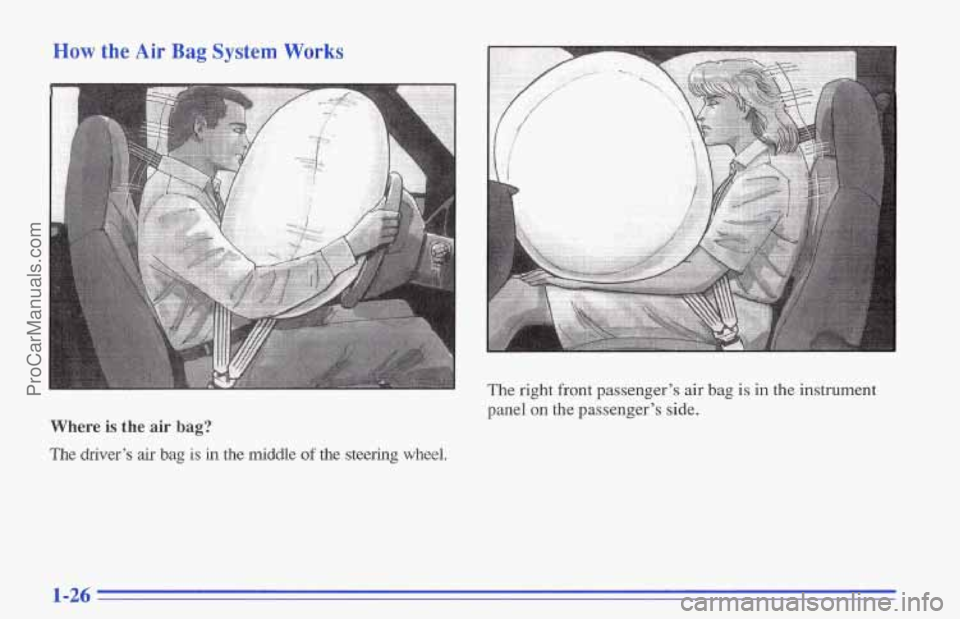
How the Air Bag System Works
Where is the air bag?
The driver’s air bag is in the middle of the steering wheel.
P
’ The right front passenger’s air bag is in the instrument
panel
on the passenger’s side.
1-26
ProCarManuals.com
Page 34 of 387
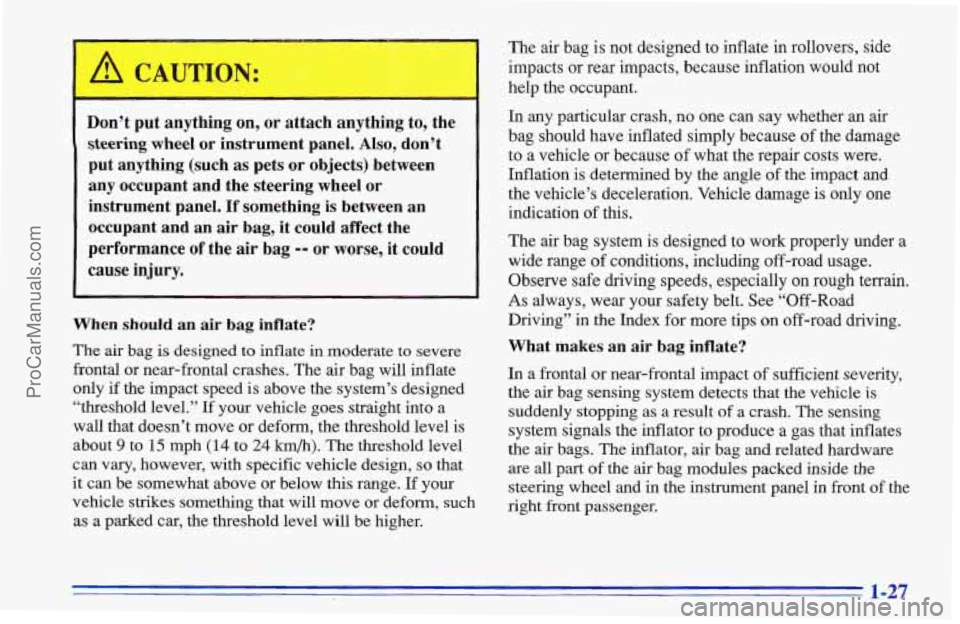
Don’t put anything on, or attach anything to, the
steering wheel or instrument panel. Also, don’t
put anything (such as pets or objects) between
any occupant and the steering wheel or instrument panel. If something is between an
occupant and an air bag, it could affect the
performance of the air bag
-- or worse, it could
cause injury.
When
should an air bag inflate?
The air bag is designed to inflate in moderate to severe
frontal or near-frontal crashes. The air bag will inflate
only
if the impact speed is above the system’s designed
“threshold level.” If your vehicle goes straight into a
wall that doesn’t move or deform, the threshold level is
about
9 to 15 mph (14 to 24 km/h). The threshold level
can vary, however, with specific vehicle design,
so that
it can be somewhat above or below this range. If your
vehicle
strikes something that will move or deform, such
as a parked car, the threshold level
will be higher. The
air bag is not designed to inflate in rollovers, side
impacts or rear impacts, because inflation would not
help the occupant.
In any particular crash, no one can say whether
an air
bag should have inflated simply because of the damage
to a vehicle or because of what the repair costs were.
Inflation is determined by the angle of the impact and
the vehicle’s deceleration. Vehicle damage is only one
indication
of this.
The air bag system is designed to work properly under a
wide range
of conditions, including off-road usage.
Observe safe driving speeds, especially on rough terrain.
As always, wear your safety belt. See “Off-Road
Driving”
in the Index for more tips on off-road driving.
What makes an air bag inflate?
In a frontal or near-frontal impact of sufficient severity,
the air bag sensing system detects that the vehicle
is
suddenly stopping as a result of a crash. The sensing
system signals the inflator to produce a gas that inflates
the air
bags. The inflator, air bag and related hardware
are all part of the air bag modules packed inside the
steering wheel and in the instrument panel in front of the
right front passenger.
1-27
ProCarManuals.com
Page 35 of 387
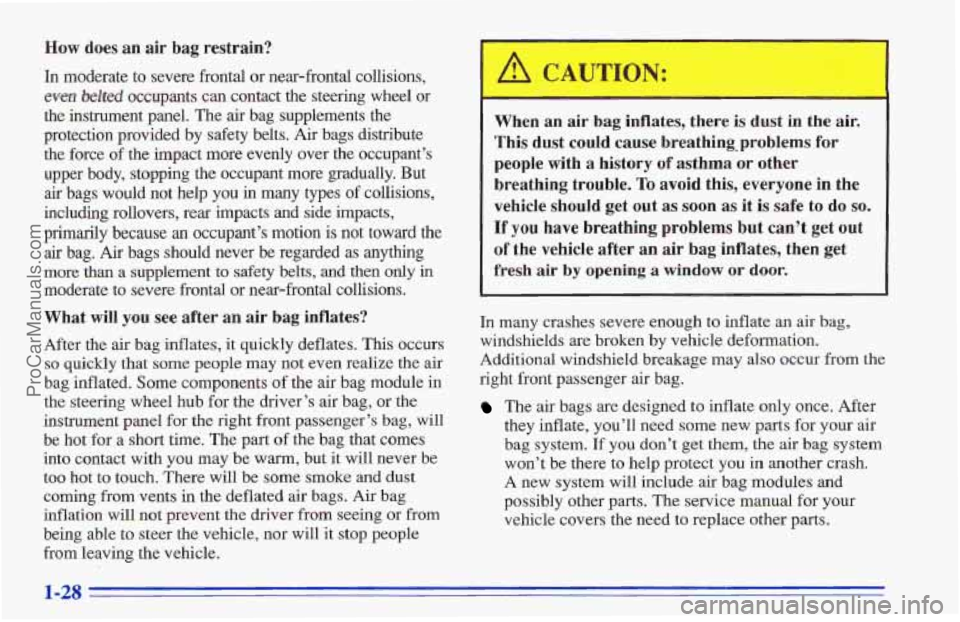
How does an air bag restrain?
In moderate to severe frontal or near-frontal collisions,
even belted occupants can contact the steering wheel or
the instrument panel. The air bag supplements the
protection provided by safety belts.
Air bags distribute
the force
of the impact more evenly over the occupant’s
upper body, stopping the occupant more gradually. But
air bags would not help you in many types of collisions,
including rollovers, rear impacts and side impacts,
primarily because
an occupant’s motion is not toward the
air bag.
Air bags should never be regarded as anything
more than a supplement to safety belts, and then only in
moderate to severe frontal or near-frontal colli.sions.
What will you see after an air bag inflates?
After the air bag inflates, it quickly deflates. This occurs
so quickly that some people may not even realize the air
bag inflated. Some components
of the air bag module in
the steering wheel hub for the driver’s air bag,
or the
instrument panel for
the right front passenger’s bag, will
be hot for a short time. The part of the bag that comes
into contact with you may be warm, but it will never be
too hot
to touch. There will be some smoke and dust
coming
from vents in the deflated air bags. Air bag
inflation will not prevent the driver from seeing or from
being able to steer the vehicle, nor will it stop people
from leaving the vehicle.
When an air bag inflates, there is dust in the air.
This dust could cause breathing-problems for
people with a history
of asthma or other
breathing trouble.
To avoid this, everyone in the
vehicle should get
out as soon as it is safe to do so.
If you have breathing problems but can’t get out
of the vehicle after an air bag inflates, then get
fresh air by opening a window or door.
In many crashes severe enough to inflate ;in air bag,
windshields
are broken by vehicle deformation.
Additional windshield breakage
may also occur from the
right front passenger air
bag.
The air bags are designed to inflate only once. After
they inflate, you’ll need some new parts for your air
bag system.
If you don’t get them, the air bag system
won’t be there to help protect you
in ‘another crash.
A new system will include air bag modules and
possibly other
parts. The service manual for your
vehicle covers the need to replace other
parts.
1-28
ProCarManuals.com
Page 36 of 387
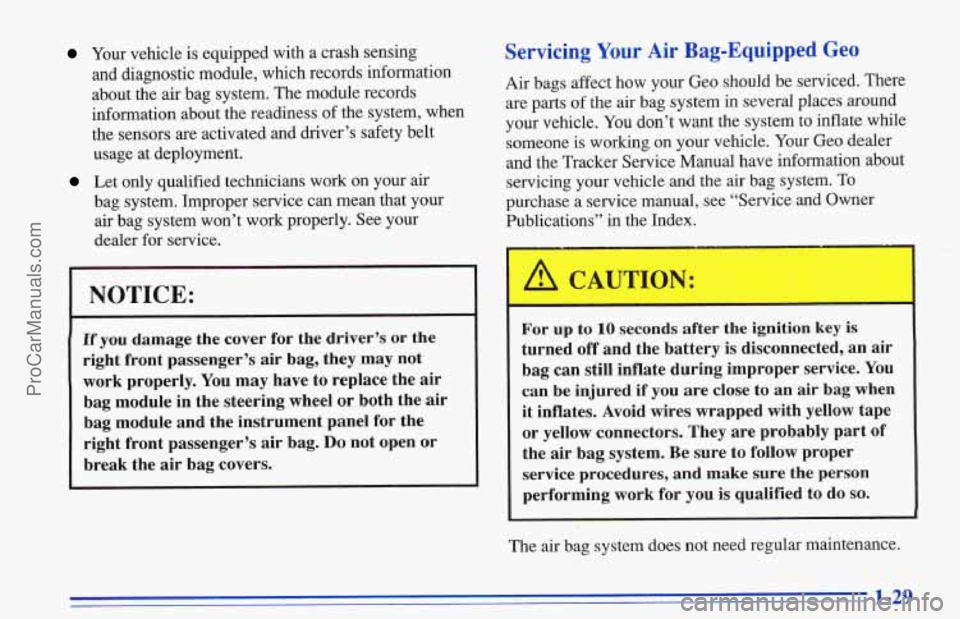
Your vehicle is equipped with a crash sensing
and diagnostic module, which records information
about the air bag system. The module records
information about the readiness
of the system, when
the sensors are activated and driver’s safety belt
usage at deployment.
bag system. Improper service can mean that your
air bag system won’t work properly. See your
dealer for service.
Let only qualified technicians work on your air
NOTICE:
If you damage the cover for the driver’s or the
right front passenger’s air bag, they may not
work properly.
You may have to replace the air
bag module in the steering wheel or both the air
bag module and the instrument panel for the
right front passenger’s air bag.
Do not open or
break the air bag covers.
Servicing Your Air Bag-Equipped Geo
Air bags affect how your Geo should be serviced. There
are parts
of the air bag system in several places around
your vehicle. You don’t want the system to inflate while
someone is working on your vehicle. Your Geo dealer
and the Tracker Service Manual have information about
servicing your vehicle and the air bag system.
To
purchase a service manual, see “Service and Owner
Publications” in the Index.
For up to 10 seconds after the ignition key is
turned off and the battery is disconnected, an air
bag can still inflate during improper service.
You
can be injured if you are close to an air bag when
it inflates. Avoid wires wrapped with yellow tape
or yellow connectors. They are probably part
of
the air bag system. Be sure to follow proper
service procedures, and make sure the person
performing work for you is qualified to do
so.
The air bag system does not need regular maintenance.
1-29
ProCarManuals.com
Page 37 of 387
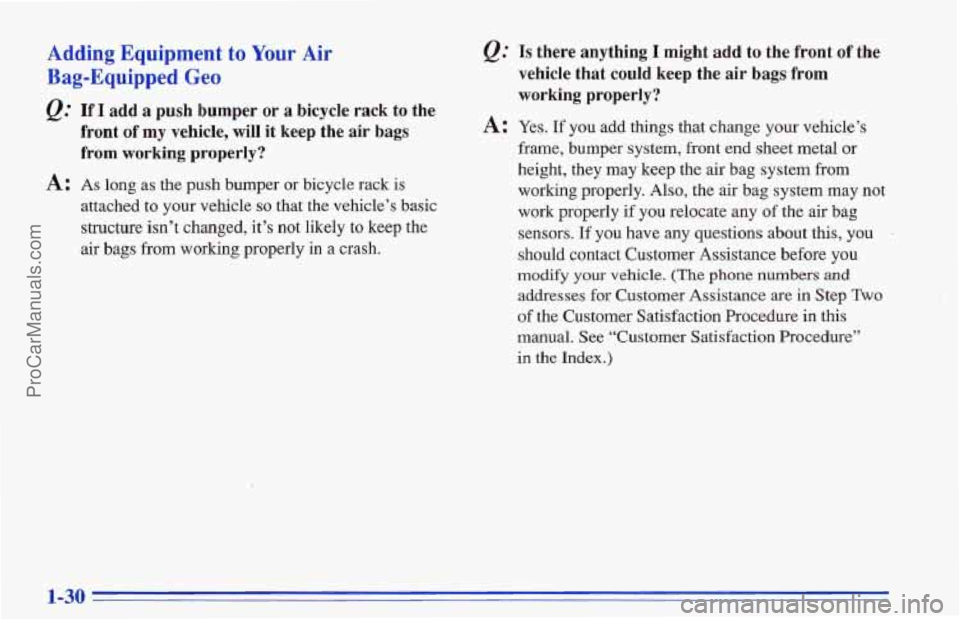
Adding Equipment to Your Air
Bag-Equipped Geo
@ If I add a push bumper or a bicycle rack to the
front
of my vehicle, will it keep the air bags
from working properly?
A: As long as the push bumper or bicycle rack is
attached to your vehicle so that the vehicle’s basic
structure isn’t changed,
it’s not likely to keep the
air bags from working properly in a crash.
@ Is there anything I might add to the front of the
vehicle that
could keep the air bags from
working properly?
A: Yes. If you add things that change your vehicle’s
frame, bumper system, front end sheet metal or
height, they may keep the air bag system
from
working properly. Also, the air bag system may not
work properly if you relocate any of the air bag
sensors.
If you have any questions about this, you .
should contact Customer Assistance before you
modify your vehicle. (The phone numbers and
addresses for Customer Assistance are in Step Two
of the Customer Satisfaction Procedure
in this
manual.
See “Customer Satisfaction Procedure”
in the Index.)
1-30
ProCarManuals.com
Page 38 of 387
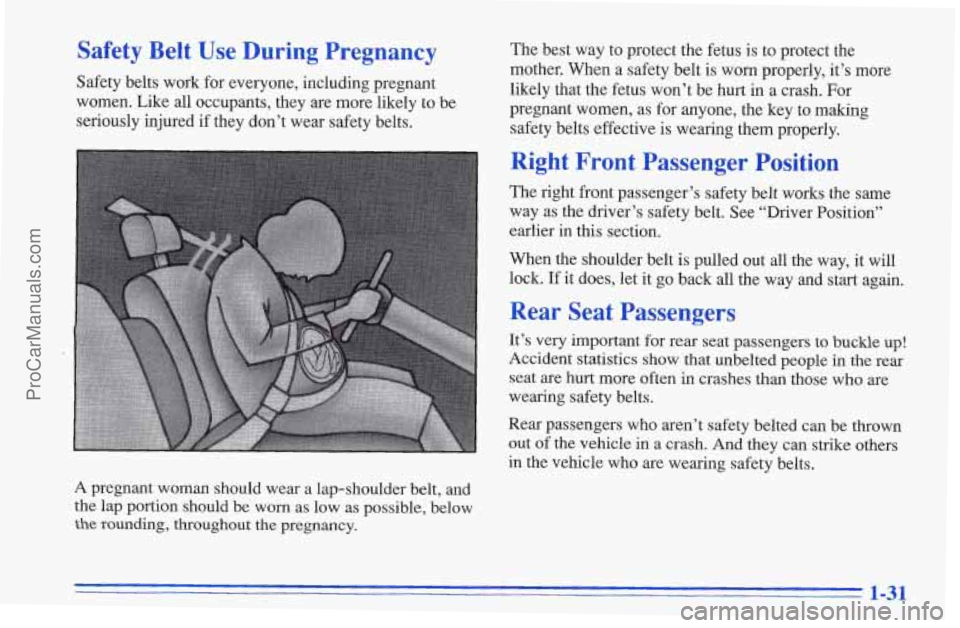
Safety Belt Use During Pregnancy
Safety belts work for everyone, including pregnant
women. Like all occupants, they are more likely to be
seriously injured
if they don’t wear safety belts.
A pregnant woman should wear a lap-shoulder belt, and
the lap portion should be worn as low as possible, below
the rounding, throughout the pregnancy. The
best way to protect the fetus is to protect the
mother. When a safety belt is worn properly,
it’s more
likely that the fetus won’t be hurt in a crash. For
pregnant women, as for anyone, the key to making
safety belts effective is wearing them properly.
Right Front Passenger Position
The right front passenger’s safety belt works the same
way as the driver’s safety belt. See “Driver Position”
earlier in this section.
When the shoulder belt
is pulled out all the way, it will
lock.
If it does, let it go back all the way and start again.
Rear Seat Passengers
It’s very important for rear seat passengers to buckle up!
Accident statistics show that unbelted people in the
rear
seat are hurt more often in crashes than those who are
wearing safety belts.
Rear passengers who aren’t safety belted can be thrown
out
of the vehicle in a crash. And they can strike others
in the vehicle who are wearing safety belts.
1-31
ProCarManuals.com
Page 39 of 387
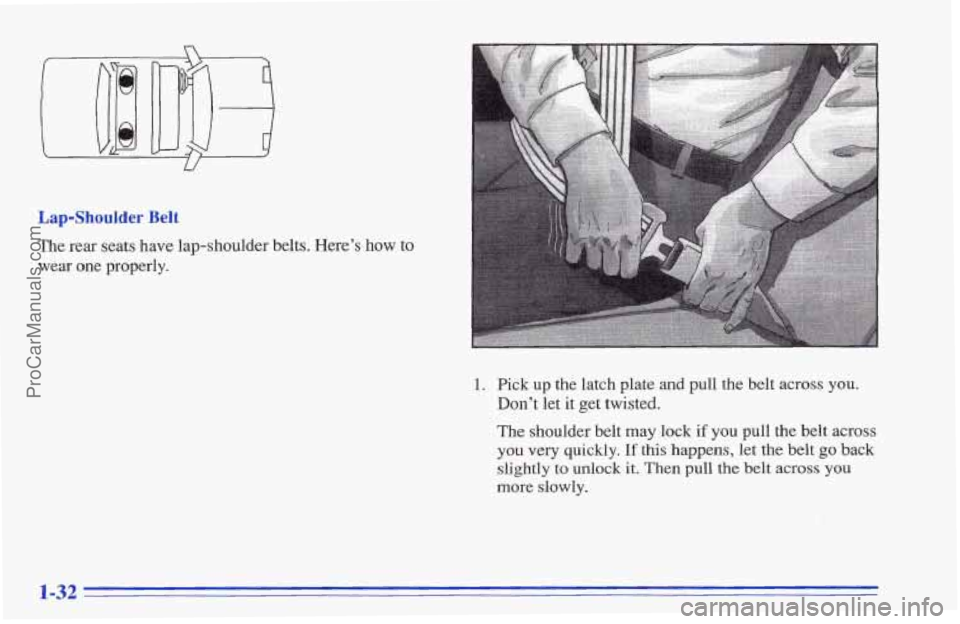
U
Lap-Shoulder Belt
The rear seats have lap-shoulder belts. Here’s how to
wear one properly.
1. Pick up the latch plate and pull the belt across you.
Don’t let it get twisted.
The shoulder belt may lock
if you pull the belt across
you very quickly. If this happens, let the belt go back
slightly to unlock it. Then pull the belt across you
more slowly.
1-32
ProCarManuals.com
Page 40 of 387

2. Push the latch plate into the buckle until it clicks.
Pull up on the latch plate to make sure it is secure.
When the shoulder belt
is pulled out all the way, it
will lock.
If it does, let it go back all the way and
start again. If the belt is not long enough, see “Safety
Belt Extender’’ at the end
of this section. Make sure
the release button on the buckle is positioned
so you
would be able to unbuckle the safety belt quickly
if
you ever had to.
3. To make the lap part tight, pull down on the buckle
end
of the belt as you pull up on the shoulder part.
The lap
part of the belt should be worn low and snug on
the hips, just touching the thighs.
In a crash, this applies
force
to the strong pelvic bones. And you’d be less likely
to slide under the lap belt. If you slid under it, the belt
would apply force at
your abdomen. This could cause
serious or even fatal injuries. The shoulder belt should go
over the shoulder and across the chest. These parts
of the
body are best able to
take belt restraining forces.
1-33
ProCarManuals.com